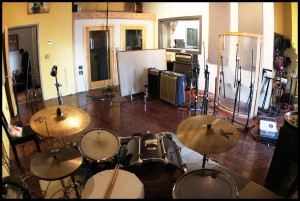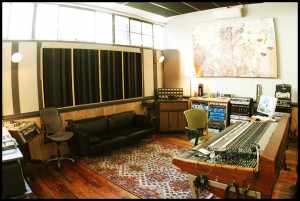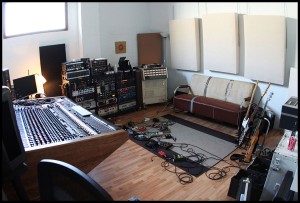Two Studios For The Price of One: Translator Audio & The Civil Defense Join Forces at South Sound
South Sound is the newly-opened home to more than a dozen rehearsal spaces and small production rooms on the Park Slope/Gowanus border of Brooklyn. It also hosts two longtime NYC studios that have banded together to share an expansive new live room, and become far larger than either studio could on its own.
Over the past ten or fifteen years, we’ve witnessed the indelible rise of a Do-It-Yourself ethos in the music industry.
But for all the benefits of that philosophy, it appears that as the music industry and the general economy finally emerge from a multi-year slump, the careers that have grown, flourished, or even just held their ground, have rarely belonged to those who have decided to “go it alone.”
Instead, the people who have been thriving in the new music business are increasingly those who have sought allies and founded meaningful communities. And that trend is continuing to grow.
As a case study, enter the new South Sound, a 7,000 square-foot collection of more than a dozen rehearsal spaces and small production rooms. It’s capped off by a beautiful new large-scale recording studio. Two of them, actually.
More and more studios have been expanding in this way.
Saltlands in DUMBO seems to add new private rooms seasonally. Both Engine Room Audio and Fireplace Studios in Manhattan have a flagship recording space with several smaller production suites each. Meanwhile, Studio G in Williamsburg has grown to 4 impressive rooms that sprawl across two neighborhoods, which are kept busy by a small handful of regular engineers and sub-tenants.
But what makes The South Sound unique is that its central large-scale tracking room is shared by two independently operated control rooms: Translator Audio and The Civil Defense.
“I’ve seen similar situations where one main studio has satellite feeds to other room,” says Andrew Schneider of Translator Audio when I ask him what inspired the idea. “But I’d never seen this exact idea where two complete studios are being fed by one live room.”
“What I really wanted to have was a studio that wasn’t compromised by the state of the industry,” Schneider says, with a laugh.
“That started us brainstorming on how we could achieve that – How we could have a room that’s big enough to record a rock band – with real estate prices in New York City what they are and with budgets going down.”
So, after Schneider was priced out of his lease in DUMBO, he teamed up with Jeremy Scott of The Civil Defense, who had taken over his older, smaller studio in Williamsburg when he had moved out.
Luckily, Scott was looking to upgrade as well, and although the idea was unconventional, he said it made sense to him immediately:
“The way that Andrew and I work, we both spend a lot of time on mixing,” Scott says. “So for half the record or more, you don’t really need the big live room space.”
“It just seemed really natural from the outset. I’ve worked out of a lot of shared spaces, and to make it work this way is even better, because we can work simultaneously.”
And great pains were taken to make sure Schneider and Scott can do just that. In addition to the main live room and its pair of dedicated iso booths, both of the studios – which are mirror images of one another – have their own smaller tracking space: an ample booth with high ceilings and direct sight-lines to the main room.
Sound isolation is achieved through floated floors, along with doubled-up drywall and glass panes with a foot of soundproofed space in-between.
Scott says there haven’t been any problems yet – even though Schneider often works with extremely loud bands like Unsane, and he often finds himself working on projects with an ephemeral, neo-shoegaze tinge.
In addition to Jeremy Scott and his longtime partner Mike Law, Scheider also found a small community of close-knit partners to help fund, manage and build the new space.
One of them, Dennis Darcy, a veteran of the studio construction business who’s done design and implementation for both Manhattan Center Studios and the Blue Man Group’s LoHo Studio, helped bring Schneider and Scott’s vision to life.
Still, “It was a little bit of an experiment,” says Schneider.
“As always, when you’re building a studio you can do all the research and planning and have it look good on paper, but it’s not until you bring up the faders that you know what you’re dealing with. And we’ve been lucky. It’s working out really well.”
Currently, Schneider has managed to book dates on his calendar through June, and Scott’s work is picking up as well, thanks to the new space.
In the past, the two had sometimes used outside studios (Scott often tracked at Martin Bisi’s legendary BC Studio, just a few blocks from the new space) or made do in cramped quarters. Now they’re able to do more than before, and with less overhead.
For Schneider, there’s a simple equation that proves it’s all been worthwhile. “Space: Better,” he says, “Rent: Cheaper.”
The South Sound had its grand opening party on Saturday, but most of its spaces are already taken and are in operation. A couple of rooms however, are still available in the emerging community. Rehearsal room shares start as low as $300/month, with the very largest private spaces going for up to $1,100/month, exclusive.
Justin Colletti is a producer/engineer, professor and journalist who lives in Brooklyn. He is a regular contributor to SonicScoop and edits the online musician magazine Trust Me, I’m a Scientist.
Please note: When you buy products through links on this page, we may earn an affiliate commission.









